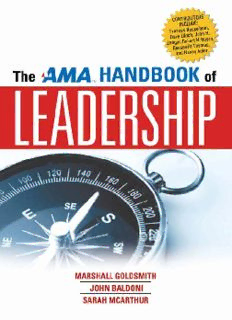Table Of ContentTHE AMA HANDBOOK OF LEADERSHIP
This page intentionally left blank
THE AMA HANDBOOK OF LEADERSHIP
➤
Marshall Goldsmith
➤
John Baldoni
➤ Sarah McArthur
Foreword by James M.Kouzes
American Management Association
New York •Atlanta•Brussels•Chicago •Mexico City •
San Francisco •Shanghai•Tokyo •Toronto •Washington,D.C.
Bulk discounts available. For details visit:
www.amacombooks.org/go/specialsales
Or contact special sales:
Phone: 800-250-5308
Email: [email protected]
View all the AMACOM titles at: www.amacombooks.org
This publication is designed to provide accurate and authoritative information in regard to
the subject matter covered. It is sold with the understanding that the publisher is not
engaged in rendering legal, accounting, or other professional service. If legal advice or other
expert assistance is required, the services of a competent professional person should be
sought.
Library of Congress Cataloging-in-Publication Data
Goldsmith, Marshall.
The AMAhandbook of leadership / Marshall Goldsmith, John Baldoni, Sarah
McArthur; foreword by James Kouzes.
p. cm.
Includes bibliographical references and index.
ISBN-13: 978-0-8144-1513-9 (hardcover)
ISBN-10: 0-8144-1513-X (hardcover)
1. Leadership--Handbooks, manuals, etc. I. Baldoni, John. II. McArthur,
Sarah. III. Title.
HD57.7.G66394 2010
658.4'092--dc22
2009037627
©2010 Marshall Goldsmith, John Baldoni, and Sarah McArthur
All rights reserved.
Printed in the United States of America.
This publication may not be reproduced, stored in a retrieval system, or transmitted in
whole or in part, in any form or by any means, electronic, mechanical, photocopying,
recording, or otherwise, without the prior written permission of AMACOM, a division
of American Management Association, 1601 Broadway, New York, NY10019.
About AMA
American Management Association (www.amanet.org) is a world leader in talent develop-
ment, advancing the skills of individuals to drive business success. Our mission is to sup-
port the goals of individuals and organizations through a complete range of products and
services, including classroom and virtual seminars, webcasts, webinars, podcasts, confer-
ences, corporate and government solutions, business books, and research. AMA’s approach
to improving performance combines experiential learning—learning through doing—with
opportunities for ongoing professional growth at every step of one’s career journey.
Printing number
10 9 8 7 6 5 4 3 2 1
C O N T E N T S
Foreword by James M.Kouzes ix
Acknowledgments xi
About the Editors xiii
Introduction 1
PART ONE Forging Ahead: The Global Picture
1 Diversity:The Imperative for Today’s Leaders 9
Frances Hesselbein
2 Leadership and Diversity Management:Unfinished
Business 15
R.Roosevelt Thomas,Jr.
3 360 for Global Leaders:Coaching Through a World
Lens 25
Maya Hu-Chan
4 Asian and Western Executive Styles 35
D.Quinn Mills and Luke Novelli,Jr.
PART TWO Developing People: The Key to the Future
5 Passing the Baton:Developing Your Successor 51
Marshall Goldsmith
6 Developing Exceptional Leaders:Critical Success
Factors 61
James F.Bolt
American Management Association
www.amanet.org v
vi Contents
7 The Leader’s Role in Growing New Leaders 75
Beverly Kaye
8 Talent Pool or Talent Puddle:Where’s the Talent in
Talent Management? 83
Marc Effron and Miriam Ort
9 The Cost of Investing in People Leadership Negatively
Affects the Bottom Line:Fact or Fiction? 91
Howard J.Morgan and Paula Kruger
PART THREE Engaging People: The Force of Change
10 Leadership’s Silver Bullet:The Magic of Inspiration 103
John H.(Jack) Zenger
11 Create Awareness; Create Change 111
Judith M.Bardwick
12 I Really Do Care! 121
Joseph Folkman
13 The Real Legacy of Leadership:Aligning Rhetoric
with Reality 133
Albert A.Vicere
14 What Do Leaders Need to Know About Generation Y
in Order to Lead Successfully? 145
Paul Hersey
PART FOUR Facilitating Change: The Leader’s Role
15 What Is an Effective Leader? The Leadership Code
and Leadership Brand 157
Norm Smallwood and Dave Ulrich
16 Leading the Emotional Side of Change:The New
21st-Century Leadership Capability 167
Robert H.Rosen
American Management Association
www.amanet.org
Contents vii
17 Adjusting the Political Temperature of Your Team 179
Gary Ranker and Colin Gautrey
18 Making Successful Transitions:The Leader’s
Perspective 187
Patricia Wheeler
19 A Question of Leadership:What Does the Organization
Need Me to Do? 203
John Baldoni
PART FIVE Taking the Lead: The X Factors
20 Situational Intelligence 213
Laurence S.Lyons
21 The Arts and Leadership 219
Nancy J.Adler
22 Client Leadership:Leading in the Marketplace 231
Andrew Sobel
23 Leading for Sustainability 249
Fons Trompenaars and Peter Woolliams
Index 261
American Management Association
www.amanet.org
This page intentionally left blank
F O R E W O R D
Imagine you’re sitting in a meeting with a group of your
colleagues. The door to the conference room opens, in
walks a person you’ve never met before, and she says,
“Hi, I’m your new leader.”
What questions do you immediately want to ask this person?
My coauthor, Barry Posner, and I regularly present this
scenario to people as part of our ongoing leadership
research. People have lots and lots of questions, but by far
the most frequently asked is: Who are you?
If you are the leader who walks into that room one day,
it’s the first question you must be prepared to answer.
People want to know about you. They want to know
about your values and beliefs, what you really care about,
and what keeps you awake at night. They want to know
who most influenced you, what prepares you for the job
you’re doing, and what you’re like as a person. They
want to know what drives you, what makes you happy,
and what ticks you off. They want to know why you want
to be their leader and why they ought to be following you.
They want to know if you play the piano—or something
else—and they want to know something about your fam-
ily. They want to know your personal story.
Wanting to know who you are isn’t about prying. It’s
about learning to trust. We’re just more likely to trust
people we know, and the more we know about our lead-
ers the more likely we are to trust them as human beings.
Of course, before you can share any of this with others,
you have to have clarity about it yourself. You have to
know you before others can truly know you.
American Management Association
www.amanet.org ix

